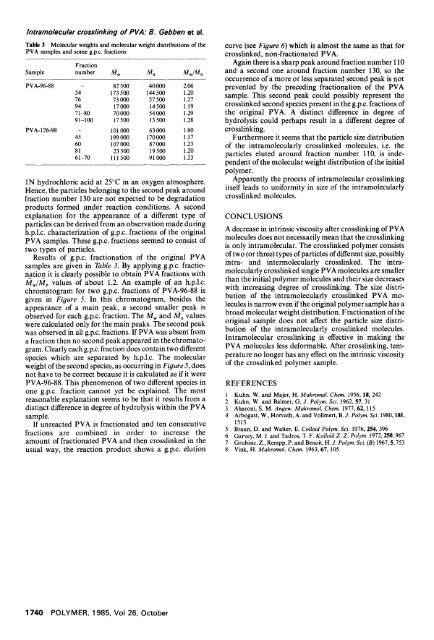Intramolecular crosslinking of poly(vinyl alcohol)
Intramolecular crosslinking of poly(vinyl alcohol)
Intramolecular crosslinking of poly(vinyl alcohol)
You also want an ePaper? Increase the reach of your titles
YUMPU automatically turns print PDFs into web optimized ePapers that Google loves.
<strong>Intramolecular</strong> <strong>crosslinking</strong> <strong>of</strong> PVA: B. Gebben et al.<br />
Table 3 Molecular weights and molecular weight distributions <strong>of</strong> the<br />
PVA samples and some g.p.c, fractions<br />
Fraction<br />
Sample number A~ w A~ n /~w/Mn<br />
PVA-96-88 - 82 500 40 000 2.06<br />
54 173 500 144 500 1.20<br />
76 73 000 57 500 1.27<br />
94 17000 14500 1.19<br />
71-80 70000 54000 1.29<br />
91-100 17 500 13 500 1.28<br />
PVA-126-98 - 101 000 63 000 1.60<br />
45 199 000 170000 1.17<br />
60 107 000 87 000 1.23<br />
81 23 500 19 500 1.20<br />
61-70 111 500 91 000 1.23<br />
1N hydrochloric acid at 25°C in an oxygen atmosphere.<br />
Hence, the particles belonging to the second peak around<br />
fraction number 130 are not expected to be degradation<br />
products formed under reaction conditions. A second<br />
explanation for the appearance <strong>of</strong> a different type <strong>of</strong><br />
particles can be derived from an observation made during<br />
h.p.l.c, characterization <strong>of</strong> g.p.c, fractions <strong>of</strong> the original<br />
PVA samples. These g.p.c, fractions seemed to consist <strong>of</strong><br />
two types <strong>of</strong> particles.<br />
Results <strong>of</strong> g.p.c, fractionation <strong>of</strong> the original PVA<br />
samples are given in Table 3. By applying g.p.c, fractio-<br />
nation it is clearly possible to obtain PVA fractions with<br />
Mw/Mn values <strong>of</strong> about 1.2. An example <strong>of</strong> an h.p.l.c.<br />
chromatogram for two g.p.c, fractions <strong>of</strong> PVA-96-88 is<br />
given in Figure 5. In this chromatogram, besides the<br />
appearance <strong>of</strong> a main peak, a second smaller peak is<br />
observed for each g.p.c, fraction. The M, and M, values<br />
were calculated only for the main peaks. The second peak<br />
was observed in all g.p.c, fractions. If PVA was absent from<br />
a fraction then no second peak appeared in the chromato-<br />
gram. Clearly each g.p.c, fraction does contain two different<br />
species which are separated by h.p.l.c. The molecular<br />
weight <strong>of</strong> the second species, as occurring in Figure 5, does<br />
not have to be correct because it is calculated as if it were<br />
PVA-96-88. This phenomenon <strong>of</strong> two different species in<br />
one g.p.c, fraction cannot yet be explained. The most<br />
reasonable explanation seems to be that it results from a<br />
distinct difference in degree <strong>of</strong> hydrolysis within the PVA<br />
sample.<br />
If unreacted PVA is fractionated and ten consecutive<br />
fractions are combined in order to increase the<br />
amount <strong>of</strong> fractionated PVA and then crosslinked in the<br />
usual way, the reaction product shows a g.p.c, elution<br />
1740 POLYMER, 1985, Vol 26, October<br />
curve (see Figure 6) which is almost the same as that tor<br />
crosslinked, non-fractionated PVA.<br />
Again there is a sharp peak around fraction number 110<br />
and a second one around fraction number 130, so the<br />
occurrence <strong>of</strong> a more or less separated second peak is not<br />
prevented by the preceding fractionation <strong>of</strong> the PVA<br />
sample. This second peak could possibly represent the<br />
crosslinked second species present in the g.p.c, fractions <strong>of</strong><br />
the original PVA. A distinct difference in degree <strong>of</strong><br />
hydrolysis could perhaps result in a different degree <strong>of</strong><br />
<strong>crosslinking</strong>.<br />
Furthermore it seems that the particle size distribution<br />
<strong>of</strong> the intramolecularly crosslinked molecules, i.e. the<br />
particles eluted around fraction number 110, is inde-<br />
pendent <strong>of</strong> the molecular weight distribution <strong>of</strong> the initial<br />
<strong>poly</strong>mer.<br />
Apparently the process <strong>of</strong> intramolecular <strong>crosslinking</strong><br />
itself leads to uniformity in size <strong>of</strong> the intramolecularly<br />
crosslinked molecules.<br />
CONCLUSIONS<br />
A decrease in intrinsic viscosity after <strong>crosslinking</strong> <strong>of</strong> PVA<br />
molecules does not necessarily mean that the <strong>crosslinking</strong><br />
is only intramolecular. The crosslinked <strong>poly</strong>mer consists<br />
<strong>of</strong> two (or three) types <strong>of</strong> particles <strong>of</strong> different size, possibly<br />
intra- and intermolecularly crosslinked. The intra-<br />
molecularly crosslinked single PVA molecules are smaller<br />
than the initial <strong>poly</strong>mer molecules and their size decreases<br />
with increasing degree <strong>of</strong> <strong>crosslinking</strong>. The size distri-<br />
bution <strong>of</strong> the intramolecularly crosslinked PVA mo-<br />
lecules is narrow even if the original <strong>poly</strong>mer sample has a<br />
broad molecular weight distribution. Fractionation <strong>of</strong> the<br />
original sample does not affect the particle size distri-<br />
bution <strong>of</strong> the intramolecularly crosslinked molecules.<br />
<strong>Intramolecular</strong> <strong>crosslinking</strong> is effective in making the<br />
PVA molecules less deformable. After <strong>crosslinking</strong>, tem-<br />
perature no longer has any effect on the intrinsic viscosity<br />
<strong>of</strong> the crosslinked <strong>poly</strong>mer sample.<br />
REFERENCES<br />
1 Kuhn, W. and Majer, H. Makromol. Chem. 1956, 18, 242<br />
2 Kuhn, W. and Balmer, G. J. Polym. Sci. 1962, 57, 31<br />
3 Aharoni, S. M. Angew. Makromol. Chem. 1977, 62, 115<br />
4 Arbogast, W., Horvath, A. and Vollmert, B. J. Polym. Sci. 1980, 181,<br />
1513<br />
5 Braun, D. and Walter, E. Colloid Polym. Sci. 1976, 254, 396<br />
6 Garvey, M. J. and Tadros, T. F. Kolloid Z. Z.-Polym. 1972, 250, 967<br />
7 Grubisic, Z.,Rempp, P. andBenoit, H.J. Polym. Sci.(B) 1967,5,753<br />
8 Vink, H. Makromol. Chem. 1963, 67, 105















